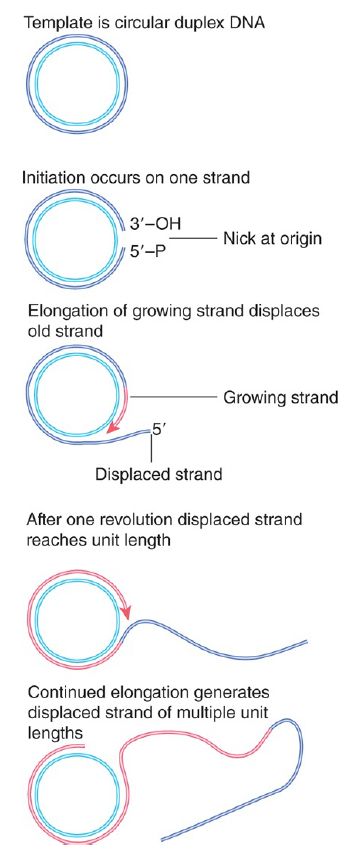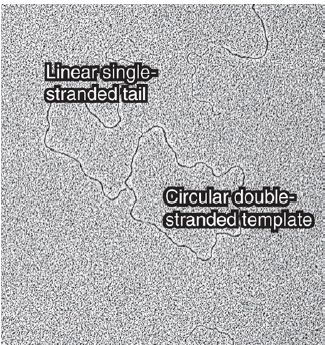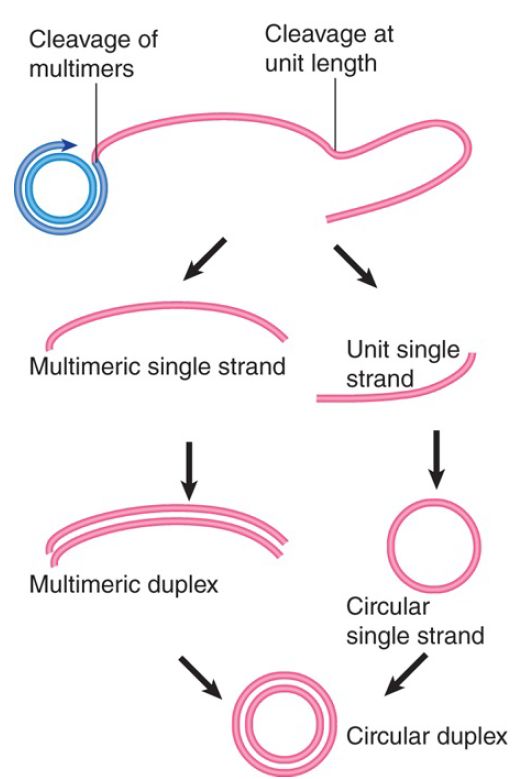


 النبات
النبات
 الحيوان
الحيوان
 الأحياء المجهرية
الأحياء المجهرية
 علم الأمراض
علم الأمراض
 التقانة الإحيائية
التقانة الإحيائية
 التقنية الحيوية المكروبية
التقنية الحيوية المكروبية
 التقنية الحياتية النانوية
التقنية الحياتية النانوية
 علم الأجنة
علم الأجنة
 الأحياء الجزيئي
الأحياء الجزيئي
 علم وظائف الأعضاء
علم وظائف الأعضاء
 الغدد
الغدد
 المضادات الحيوية
المضادات الحيوية|
Read More
Date: 6-5-2021
Date: 29-10-2015
Date: 1-12-2015
|
Rolling Circles Produce Multimers of a Replicon
KEY CONCEPT
- A rolling circle generates single-stranded multimers of the original sequence.
The structures generated by replication depend on the relationship between the template and the replication fork. The critical features are whether the template is circular or linear, and whether the replication fork is engaged in synthesizing both strands of DNA or only one.
Replication of only one strand is used to generate copies of some circular molecules. A nick opens one strand, and then the free 3′–OH end generated by the nick is extended by the DNA polymerase.The newly synthesized strand displaces the original parental strand. The ensuing events are depicted in FIGURE 1.

FIGURE 1.The rolling circle generates a multimeric singlestranded tail.
This type of structure is called a rolling circle, because the growing point can be envisaged as rolling around the circular template strand. It could in principle continue to do so indefinitely. As it moves, the replication fork extends the outer strand and displaces the previous partner. An example is shown in the electron micrograph of FIGURE 2.

FIGURE 2. A rolling circle appears as a circular molecule with a linear tail by electron microscopy.
Photo courtesy of Ross B. Inman, Institute of Molecular Virology, Bock Laboratory and Department of Biochemistry, University of Wisconsin, Madison, Wisconsin, USA.
The newly synthesized material is covalently linked to the original material, and as a result the displaced strand has the original unit genome at its 5′ end. The original unit is followed by any number of unit genomes, synthesized by continuing revolutions of the template. Each revolution displaces the material synthesized in the previous cycle.
The rolling circle is put to several uses in vivo. FIGURE 3 depicts some pathways that are used to replicate DNA.

FIGURE 3. The fate of the displaced tail determines the types of products generated by rolling circles. Cleavage at unit length generates monomers, which can be converted to duplex and circular forms. Cleavage of multimers generates a series of tandemly repeated copies of the original unit. Note that the conversion to double-stranded form could occur earlier, before the tail is cleaved from the rolling circle.
Cleavage of a unit length tail generates a copy of the original circular replicon in linear form. The linear form can be maintained as a single strand or can be converted into a duplex by synthesis of the complementary strand (which is identical in sequence to the template strand of the original rolling circle).
The rolling circle provides a means for amplifying the original (unit) replicon. This mechanism is used to generate amplified ribosomal DNA (rDNA) in the Xenopus oocyte. The genes for ribosomal RNA (rRNA) are organized as a large number of contiguous repeats in the genome. A single repeating unit from the genome is converted into a rolling circle. The displaced tail, which contains many units, is converted into duplex DNA; later it is cleaved from the circle so that the two ends can be joined together to generate a large circle of amplified rDNA. The amplified material therefore consists of a large number of identical repeating units.



|
|
|
|
إجراء أول اختبار لدواء "ثوري" يتصدى لعدة أنواع من السرطان
|
|
|
|
|
|
|
دراسة تكشف "سببا غريبا" يعيق نمو الطيور
|
|
|
|
|
|
بالفيديوغراف: ممثل المرجعية الدينية العليا والامين العام للعتبة الحسينية يتفقدان مشروع مطار كربلاء الدولي
|
|
|
|
بالصور: سنابل تفيض بالخير في مزارع العتبة الحسينية (عمليات حصاد الحنطة)
|
|
|
|
تضمنت الجولة توجيهات متعلقة براحة المسافرين.. ممثل المرجعية العليا والامين العام للعتبة الحسينية يطلعان ميدانيا على سير العمل في مطار كربلاء الدولي
|
|
|
|
بالفيديو: مركز لعلاج العقم تابع للعتبة الحسينية يعلن عن أجراء (117) عملية تلقيح اصطناعي خلال الربع الاول من العام الحالي
|